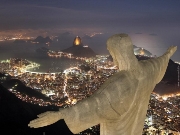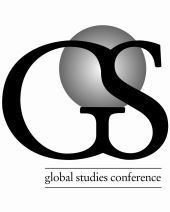Program
The Fourth Global Studies Conference took place from 18-20 July 2011.
Here you will find a digital copy of the printed program that was distributed on site, updated with any session changes that may have occurred during the conference.
Click here to view the (link will open a .pdf file).
Comprehensive presentation details may be viewed on the Session Descriptions page.
Attention Presenters
Data projectors will be provided in all of the parallel session rooms. However, you must supply your own laptop for your presentation. In addition, if you are a Mac user, you will need to bring a VGA Mac connector.
Special Theme, 2011 Conference: EMERGING SOCIETIES AND EMANCIPATION
All eyes are now on emerging markets and in emerging markets all eyes are on the middle class, which is growing by 70m a year. The middle class matters economically as consumers and culturally and politically because in values and lifestyle they seem to be similar to the middle class in the west. Focusing on the middle class comes natural to mainstream sensibilities and in the process makes the ‘rise of the rest’ appear as an extension of the rise of the west. However important the growing middle class is the central challenge of modernities, old and new, is whether they are able to integrate the rural majority. This involves structural reforms (land reform, tax reform, investments in the countryside, education and social policies), cultural legacies and perspectives on social inequality, and agency and social movements on the part of (former) peasantry.
How and on what terms the poor majority, rural and urban, participates in the new modernities determines whether the new modernities will be viable and sustainable 20 years hence. Thus a crucial story is the transformation of the peasantry, undergoing de-peasantization as migrant workers in towns, whether in the formal or informal sector, and as a workforce in factories and services. The ‘rise of the peasantry’, a vast expansion of the world’s labor force, underlies the emergence of the factory economies in Asia and Latin America.
Urban-rural, middle class-peasant frictions run through many social conflicts—such as rural protests in China, strikes at China’s Foxconn and Honda factories, Thailand’s redshirts rebelling in Bangkok, Naxalite uprisings in India, Maoists rising in Nepal. Arguably it is also a factor in many expressions of militant Islam and in the current unrest in the Middle East. Japan, South Korea, Taiwan and Turkey have achieved the integration of the rural majority and China is in the process of undertaking this. In Turkey and Bolivia the (former) peasantry is in power (Anatolian peasants and migrants are the power base of the AKP and rural indigenes support the Morales government). City states without a peasant hinterland (such as Singapore, Hong Kong and the Arabian Gulf) are part of the global equation as recipients of rural migration flows from other areas. Latin America and Brazil have experienced peasant rural-urban migration earlier than in Asia and have absorbed the rural majority more in the informal than in the formal sector.
The rise of emerging societies is now a given; multipolarity in political economy is no longer in question. What is in question is how does the rise of emerging economies affect the rural and urban poor and the informal sector? Is emancipation of the rural and poor majority part of the horizon—culturally, socially and in terms of economic growth model and policy—of Brazil, Latin America and other emerging societies?
The Conference is divided into loosely grouped streams – approximating perspectives, knowledge-bases, professional practices or disciplines.As much as possible, we try to program parallel sessions relating to each stream into the same room. This means that it would be possible, if one wished, to follow the same stream for the entire Conference.
You will be asked to select a stream when you submit your presentation proposal. If you select more than one stream or ‘other’, the Conference organisers will choose a stream based on a reading of your title and abstract, or one which seems to fit best with other presentation proposals that have been submitted.
The Global Studies Conference Streams
- Economic Perspectives
- Political Perspectives
- Cultural Perspectives
- Environmental Perspectives
- Social Perspectives
- Holistic and Theoretical Perspectives
Background
Purpose
How They Work
Facilitator
Possible Session Contents
Background
Talking circles are meetings of minds, often around points of difference or difficulty. They are common in indigenous cultures. The inherent tension of these meetings is balanced by protocols of listening and respect for varied viewpoints. From this, rather than criticism and confrontation, productive possibilities may emerge.
The Purpose of Talking Circles in this Conference
The purpose of the talking circles is to give shape to a Conference that is wide-ranging in its scope and broad-minded in its interests. They also give people an opportunity to interact around the key ideas of the Conference away from the formalities of the plenary, paper, workshop and colloquium sessions. They are places for the cross-fertilisation of ideas, where cycles of conversation are begun, and relationships and networks formed.
Talking circles are not designed to force consensus or even to strive towards commonality. Their intention is, in the first instance, to find a common ground of shared meanings and experiences in which differences are recognised and respected. Their outcome is not closure in the form of answers, but an openness that points in the direction of pertinent questions. The group finally identifies axes of uncertainty that then feed into the themes for the Conference of the following year.
How Do They Work?
The talking circles meet for two 45-minute sessions during the Conference, and the outcomes of each talking circle are reported back to the whole Conference in the closing plenary session. They are grouped around each of the Conference streams and focus on the specific areas of interest represented by each stream. Following is the talking circles outline that is currently in use, but we welcome feedback and suggestions for improvement from participants.
- Talking Circle 1 (45 minutes): Who Are We? What is our common ground?
- Talking Circle 2 (45 minutes): What is to be done?
- Closing Plenary: 15-minute contribution to the closing plenary by the talking circles facilitator.
It is important to note that each talking circle may be organised in any way that members of the group agree is appropriate. They may be informal and discursive, or structured and task-oriented. Each talking circle group has a facilitator.
The Role of the Facilitator
The facilitator must be comfortable with the process of thinking ‘out of the square’ and also embracing multiple and diverse scenarios. The process is one of creating a kind of collective intelligence around the stream. The facilitator should shape a conversation that is open to possibilities and new lines of inquiry or action; they should embody a spirit of openness to new knowledge rather than the closure of advocacy. The facilitator is required to keep a record of the main discussion points. These points need to be summarised for the talking circles facilitator who will make in a 15-minute presentation in the closing plenary session at the Conference.
Possible Session Contents – Suggestions to Assist Facilitators
Talking Circle 1 (45 minutes): Who are we?
- Orientation: members of the group briefly introduce themselves.
- What could be the narrative flow of the talking circle sessions?
- What could be the outcomes of the work of this group and its contribution to the closing plenary session, the Journal and the Conference as a whole (including the themes for next year’s Conference)?
- Assessing the landscape, mapping the territory: What is the scope of our stream? Do we want to rename it?
- What are the burning issues, the key questions for this stream?
- What are the forces or drivers that will affect us as professionals, thinkers, citizens, and aware and concerned people whose focus is this particular stream?
- Where could we be, say, ten years hence? Scenario 1: optimism of the will, Scenario 2: pessimism of the intellect.
Talking Circle 2 (45 minutes): What themes are emerging?
*What are our differences?
- The setting: present and imminent shocks, crises, problems, dilemmas – what are they and what is the range of responses?
- What are the cleavages, the points of dissonance and conflict?
- What are the dimensions of our differences (1)? Politics, society, economics, culture, technology, environment.
- What are the dimensions of our differences (2)? Persons, organisations, communities, nations, the global order.
*What is our common ground?
- Where are the moments of productive diversity?
- What are the bases for collaboration (1)? Politics, society, economics, culture, technology, environment.
- What are the bases for collaboration (2)? Persons, organisations, communities, nations, the global order.
- Alternative futures: outline several alternative scenarios.
- What are the forces that drive in the direction of, or mitigate against, each scenario?
*What is to be done?
- What’s been coming up in the parallel sessions in this stream since the last talking circle?
- What is the emerging view of the future?
- Can we foresee, let alone predict alternative futures?
- Looking back a decade hence, what might be decisive or seminal in the present?
- Scenarios: can we create images of possibility and agendas for robust alternative futures?
- Directions: conventional and unconventional wisdoms?
- Strategies: resilience in the face of the inevitable or creative adaptation?
- What could be done: review the scenarios developed in Talking Circle 1.
- Axes of uncertainty: working towards the right questions even when there’s no certainty about the answers.
Closing Plenary: 15-minute contribution to the closing plenary by the talking circles facilitator based on summaries provided by each talking circle.
![[rss]](http://onglobalisation.com/wp-content/themes/k2_1.0.3/images/feed.png)




